- Home
- :
- All Communities
- :
- Industries
- :
- Electric
- :
- Electric Blog
- :
- Live Blog: 2017 Esri GeoConX Plenary
Live Blog: 2017 Esri GeoConX Plenary
- Subscribe to RSS Feed
- Mark as New
- Mark as Read
- Bookmark
- Subscribe
- Printer Friendly Page

Welcome to the 2017 Esri GeoConX Conference Plenary! We (Christopher Catania & MMathias-esristaff ) will be sharing the latest news and updates during the plenary. Thanks for following along and we look forward to seeing your feedback and contributions in the comments below!
(click to jump ahead to section)
8:00am - Doors open and attendees are finding their way in!
8:30 - And we're live! Jeff Rashid kicks off the GeoConX 2017 welcoming more than 700 attendees and shares exciting and inspiring highlights and use cases from Utilities and Communications.

8:40 - Jack Welcome message
Jeff shares a welcome video message from Esri president and founder, Jack Dangermond.
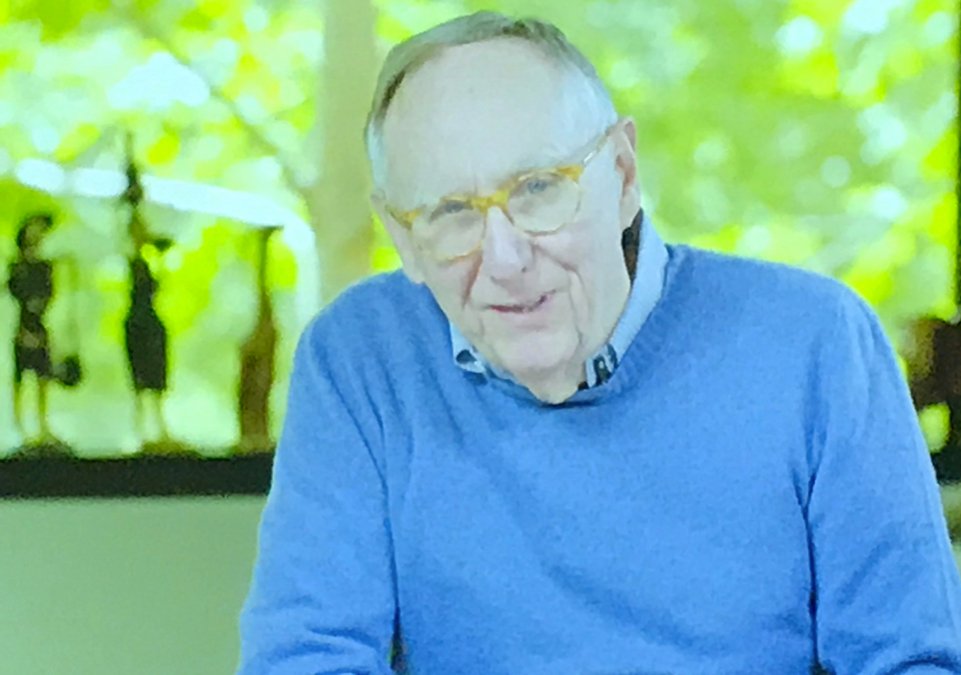
“As you know, we’ve been trying for some years to bring together the communities of electricity and gas utility users with the community of telecommunications users. We did this for a purpose. While you are very different domains with different disciplines, there is a great degree of overlap in how you both use GIS technology. The ideas in one organization can benefit another.
I want you to get to know one other. There will be a lot of opportunities over the next few days to do that. Sharing common knowledge has huge benefits in the GIS profession.
I want to talk about our work. Our work is changing the face of GIS. Over the past four years, we’ve been reengineering basically everything we do. We spent over a billion dollars on this.
It’s sort of done in the background, but those of you in business will understand the implications of the investment. We’ve been evolving the platform from client/server systems of record with big servers and thick clients to a new model. The new model is being deployed by many of you with very little disruption to the systems that you currently have.
We call this a Web GIS pattern. The fundamental difference between this and everything that preceded it is that it’s built on Web Services. This is different than just serving something out. All clients and devices—and all servers—are built on REST services. This unleashes the power of GIS across the organization.
It has the potential to increase the number of users by orders of magnitude, increasing access and value for your systems of record that you’ve invested so much in over the years. We are already seeing this happen in many different organizations. Boston went from 150 users to 6,000 users, with everyone having access to the maps and the content that is being built and managed by the organization.
In utilities, and in oil companies, and in public safety organizations (even the Red Cross), we’re seeing a great expansion in our user base. This big transformation continues to evolve, with cloud, software-as-a-service (SaaS), server-based, and enterprise-based services, the technology is evolving.
The server that you’ve been using, will continue to be used. Underneath the hood, we have re-architected the new system so that there are distributed services that are deployable almost infinitely. Some of our big customers like UPS and NOAA now have thousands of servers deployed in their business of serving out their information.
The second big thing is that field mobility has taken off. This is so important to all of you in this room. You have the power to empower the mobile worker on any device, anywhere, anytime with great information that comes out of your system of record. This means that I can extend the impact of the work and call on them to deliver up-to-date information back into my enterprise systems. This is interesting.
The pattern of Web is emerging. I can call on the information services with thin clients. I can also do updates on some of the data.
We’re here now at the introduction of a new utility-focused network model. This is a change that we’ve been working on for almost five years, as many of you know that have been working with us on this. We’ve spent a great deal of money and time researching, implementing, and now delivering this new network model.
The network model is services based. It’s a network model that is richer than our traditional network database. It allows you to view very large networks, and aligns with the complexity that many of you deal with on a daily basis. It allows for networks within networks, specialized devices, you can embed all that intelligence within your network model, helping you manage and maintain it.
This allows us to support many of the challenges that we could simply not do in the past with the old network database. Those are challenges that are upon us, with things like IoT, smart grid, and those next-generation energy and communications networks that you’re all anticipating and envisioning.
The final piece of this next-generation technology is the desktop. I know that most of you use ArcMap to do mapping and editing. We have very carefully been re-engineering this tool in a high-performance 64-bit environment to work in both 2D and 3D. This client ArcGIS Pro, will eventually take the place of ArcMap.
First and foremost, it’s a connected client. It’s not the traditional client/server environment. It’s always connected. You can tear it off, and work disconnected, but it’s designed to work with information service from the Web, off the cloud, or in your own enterprise environment.
I really wish I was there, particularly because I’m seeing GIS technology mature immensely this year. I see GIS moving from systems of record to systems of insight, where we analyze the data, to systems of engagement where field crews, customers, managers and executives are all interacting.
I’m seeing ArcGIS go from a focused stove-piped, mission-to-mission technology, to a location-enabled technology that cuts across the entire organization.
There are great benefits to managing the systems of record well, but this transformation means that you will deliver The Science of Where across your entire organization.
Thank you again for letting me talk to you for a few moments.”
8:50 - Safety Briefing and demo
How do we get out of here? Where do we go? So we're all prepped, Joseph Marsh takes us through an important GeoConX safety briefing using interactive Esri mobile app https://community.esri.com/groups/navigator?sr=search&searchId=ce40f7d5-c331-4a9f-85cb-44aadd8f7467&... showing escape routes and key locations in downtown Chicago.

9:00am - Keynote with Jason Rodriguez from Zpryme.
Jason takes us through the "Data...The Currency of the Future" Jason explores..."What will the future look like? and "What does this mean for: utilities, telecom, and consumers?" Here's some of the highlights covering data trends, IoT, AR, grid technologies, smart cities and impact of mobile applications.

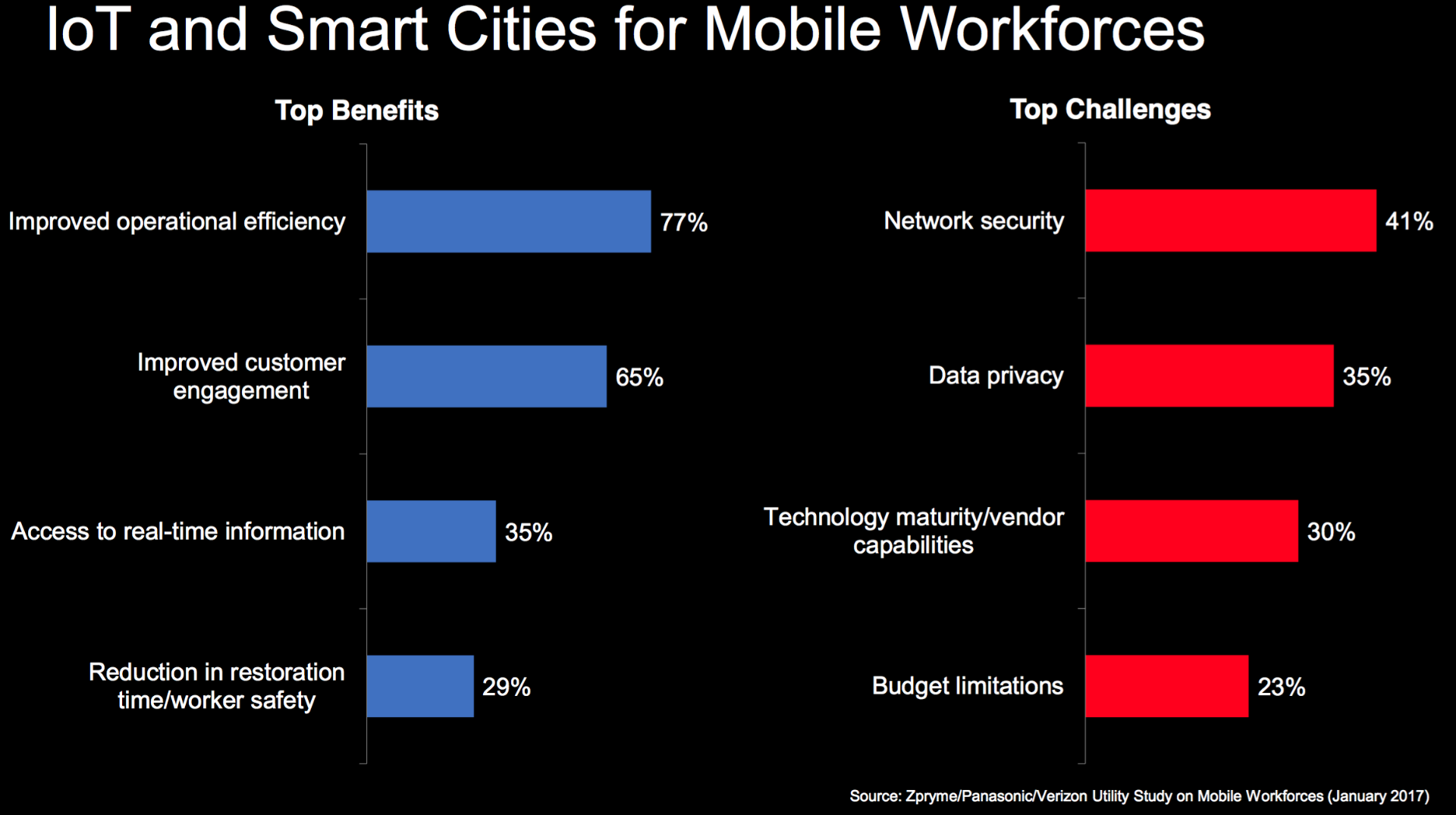



Jason shares ideas about today's technology landscape and what the future will look like for technology and utilities.
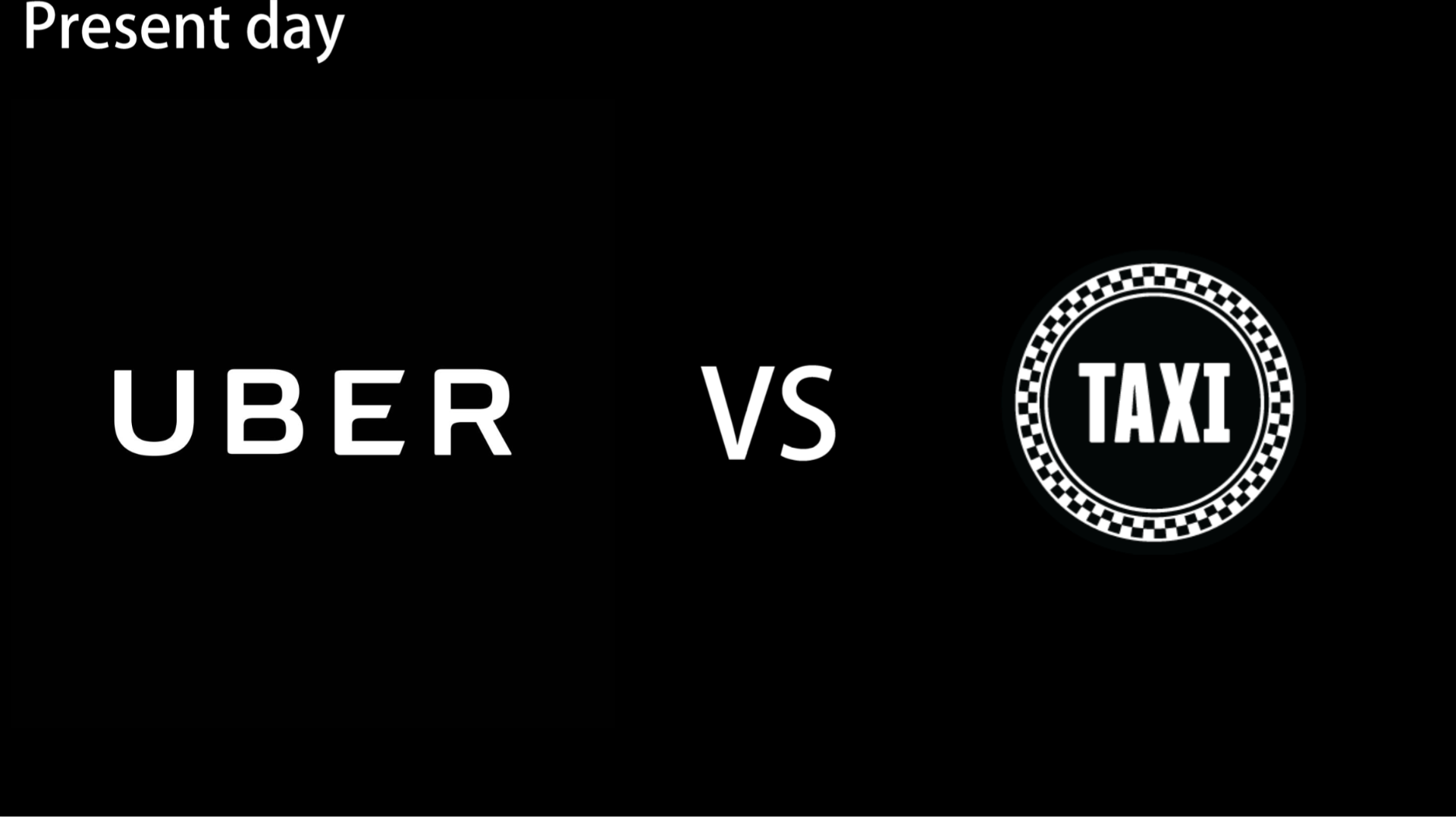

9:15am - Esri vision with Damian
Esri Solutions Director Damian Spangrud shares the vision for the Science of Where, and how GIS is a platform for workflows and collaboration.
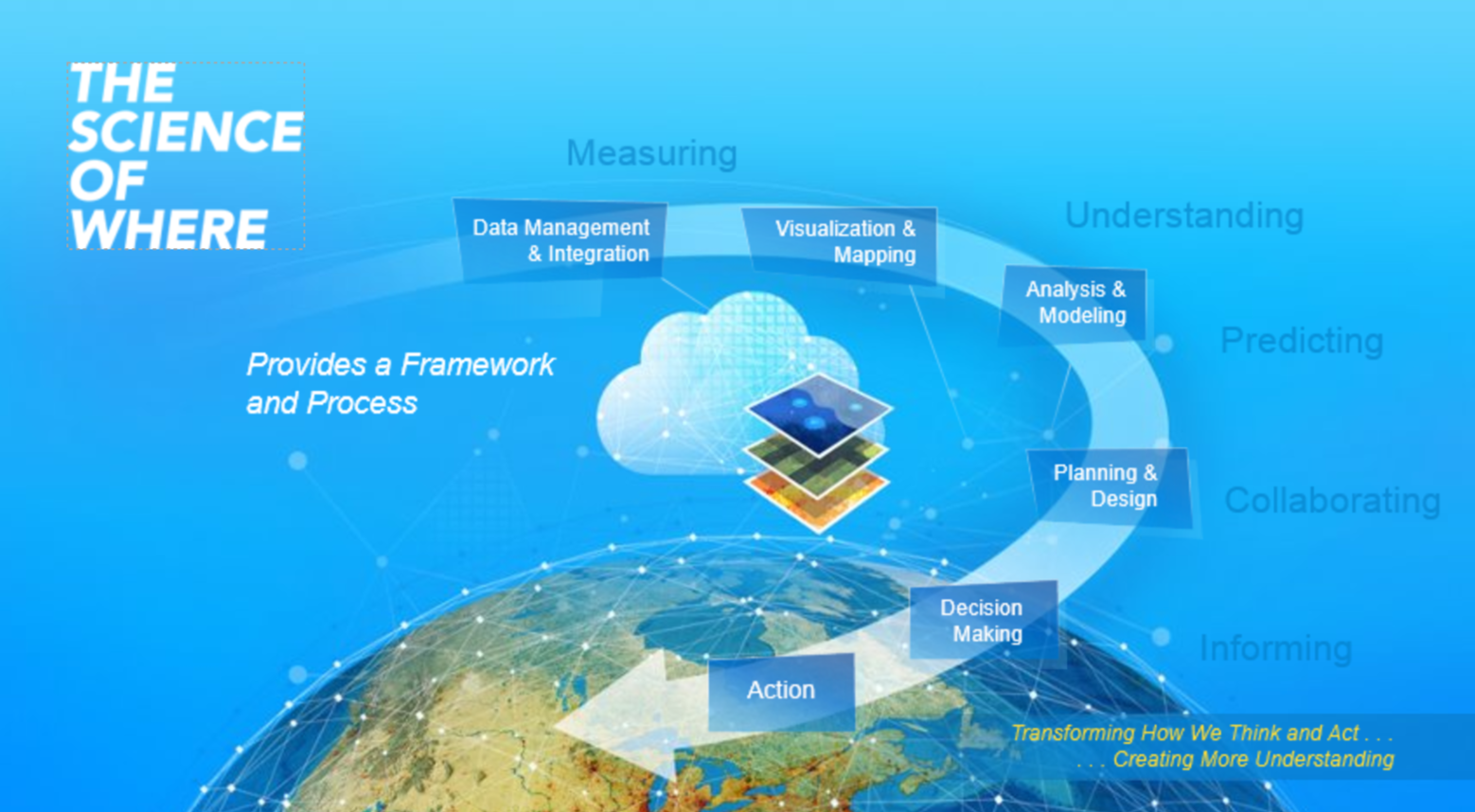
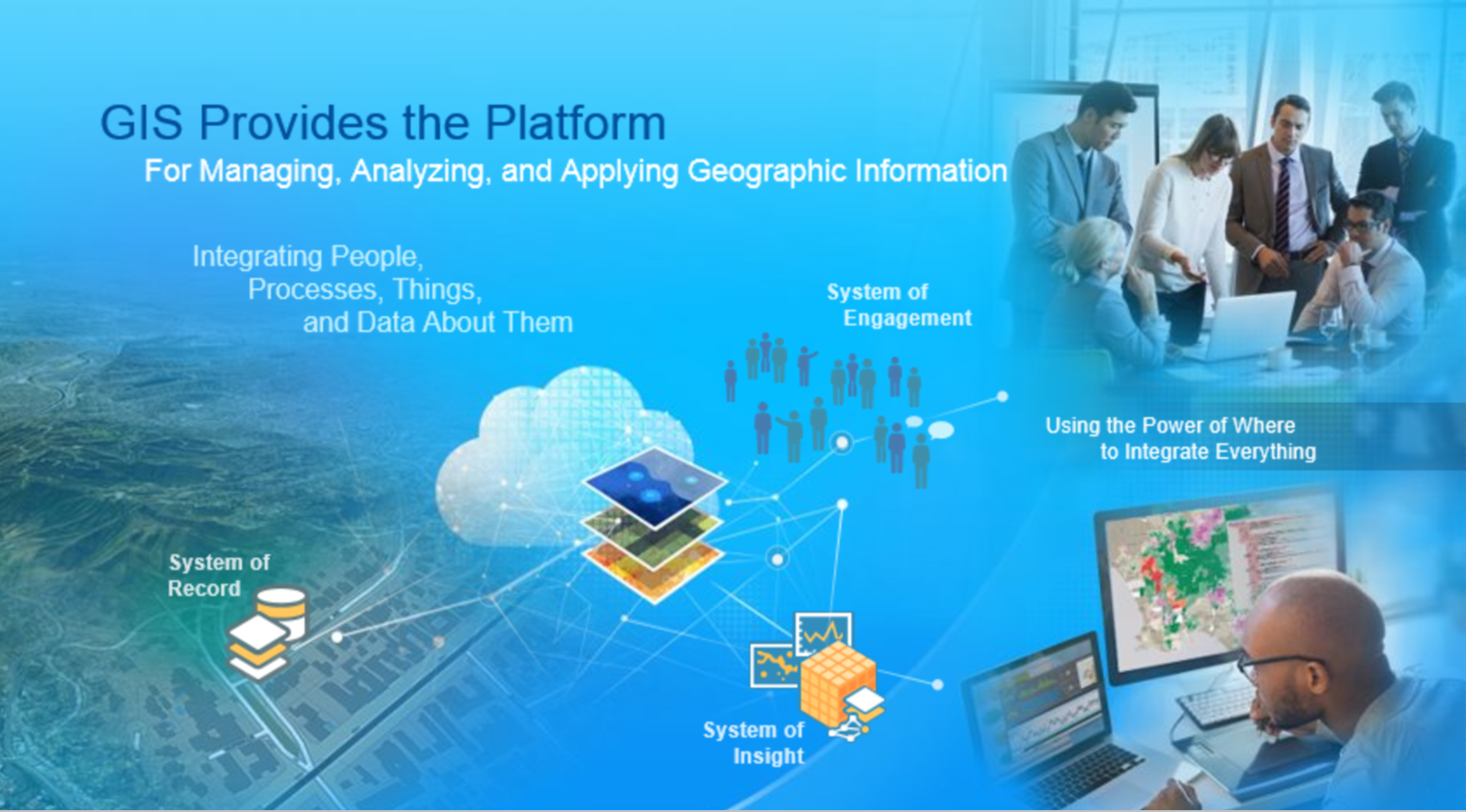
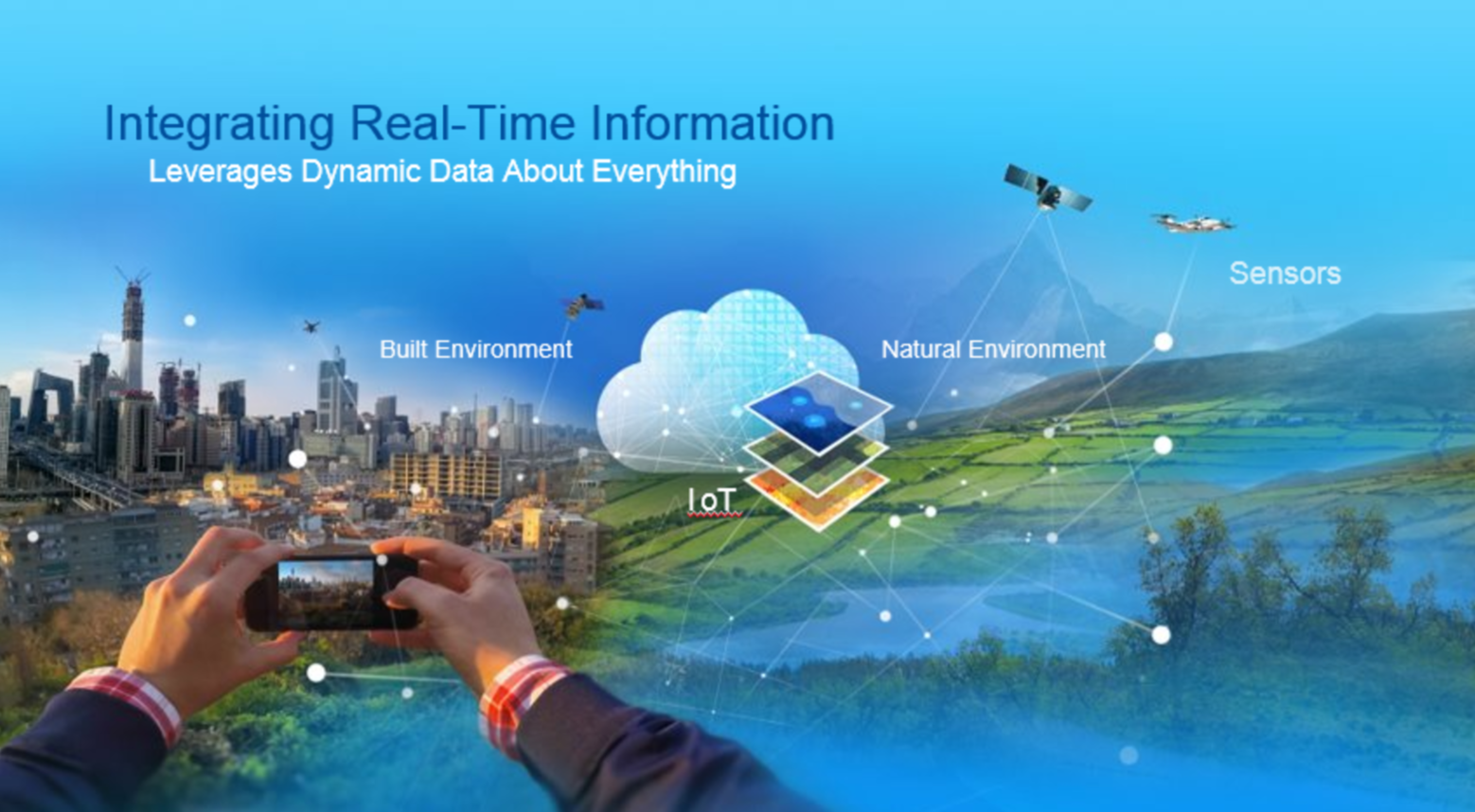
Damian stresses and highlights the importance of the utility integration, innovations and partnerships. "You – The Electric, Gas, and Telecommunications Communities are critical to Esri’s work. And we are committed to your success."

9:45am - Dominion Energy Uses Apps for Data-Driven Decisions
The Dominion team takes the stage to share how they're using apps and applying the Science of Where to their work. Let's dive into the details of their story!
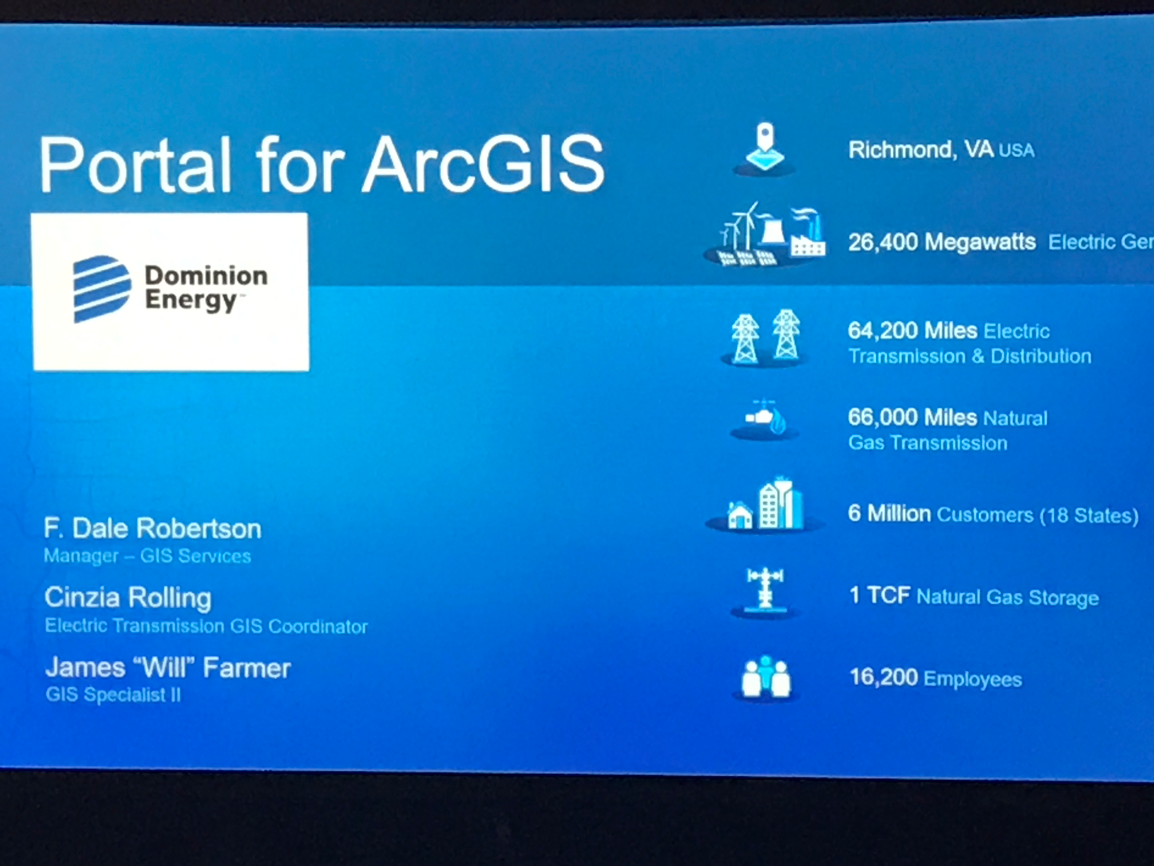
Dominion Energy, headquartered in Richmond, Virginia, generates approximately 26,400 megawatts of electricity and has 66,000 miles of natural gas storage and distribution pipeline, and 64,200 miles of electricity transmission and distribution lines. The company has one of the largest natural gas storage systems in the US, with 1 trillion cubit feet of capacity and more that 6 million utility and retain energy customers across 18 states. Dominion Energy, and their 16,200 employees, invest in the communities they serve.
Dominion Energy has been displaying and communication geospatial information for business benefits since 1998. To date, that has been via maps or app development. Creating business-specific geospatial applications has been frustrating.
When ArcGIS Portal (https://community.esri.com/community/gis/web-gis/portal-for-arcgis?sr=search&searchId=b2bff996-e31a-...) arrived, along with its integration with Collector (https://community.esri.com/community/gis/applications/collector-for-arcgis?sr=search&searchId=d23b2a...), app development changed. Collector allows Dominion Energy to collect data in the field using a collection form for the iPhone and iPad, including the capture of videos and pictures. Portal offers the capability to aggregate information, including the collection of information from far-flung crews for an Initial Damage Assessment during major storm events.
What began as a demo to the Election Distribution group with 10 users in an enterprise production environment became a system-wide dill with more than 650 named users within days.
The journey began with an investment in a Portal sandbox after being introduced to the technology at a conference. They began to configure geospatial application to meet identified business needs. When working on the Initial Damage Assessment, they soon realized that they could view damage in almost real time.
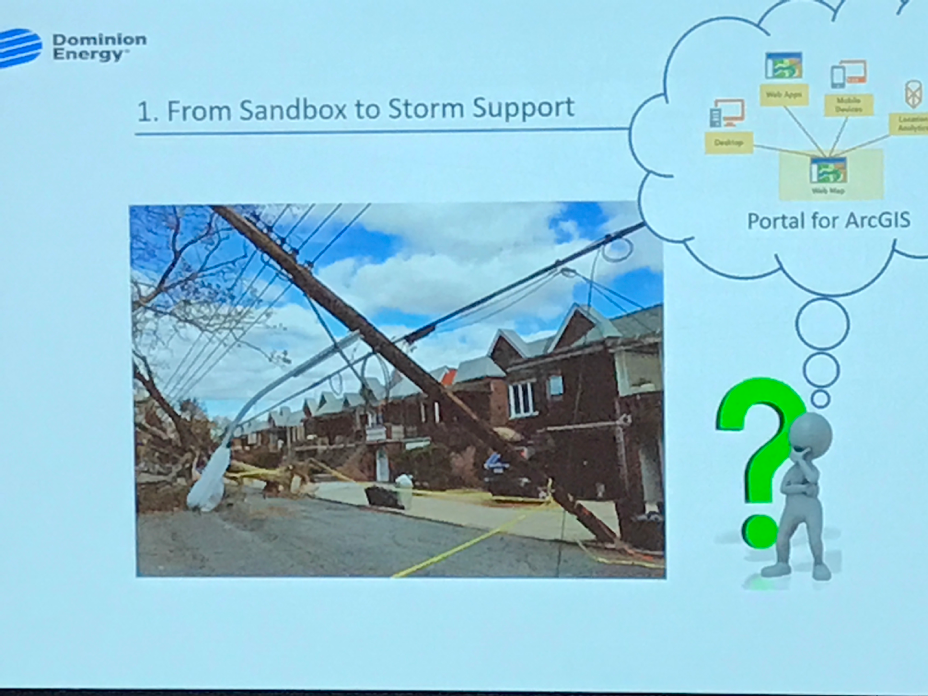
During the demo, the Director of Operations made a comment that it would be nice to see a dashboard-like summary. One of the GIS specialists was able to quickly create just such a dashboard in just 15 minutes.
When the specialist asked, “Is this what you’re looking for?” The director exclaimed, “Exactly!”
Shortly after this exercise, Dominion Energy was awarded the bid to operate both the electric and gas networks at Fort Hood in Klllene, Texas, the US Army’s largest base in the nation. The first priority in assuming operations was to survey, collect and mode the electric and gas network on the base.
The duo of Collector and Portal allowed the business to quickly stand up a GIS for Fort Hood. They quickly created a Gas Leak app using Collector that allowed the Dominion gas team to respond to gas leaks. This was quickly followed by apps for corrosion protection, cathodic protection, and overall safety reporting for federal, state and local compliance.
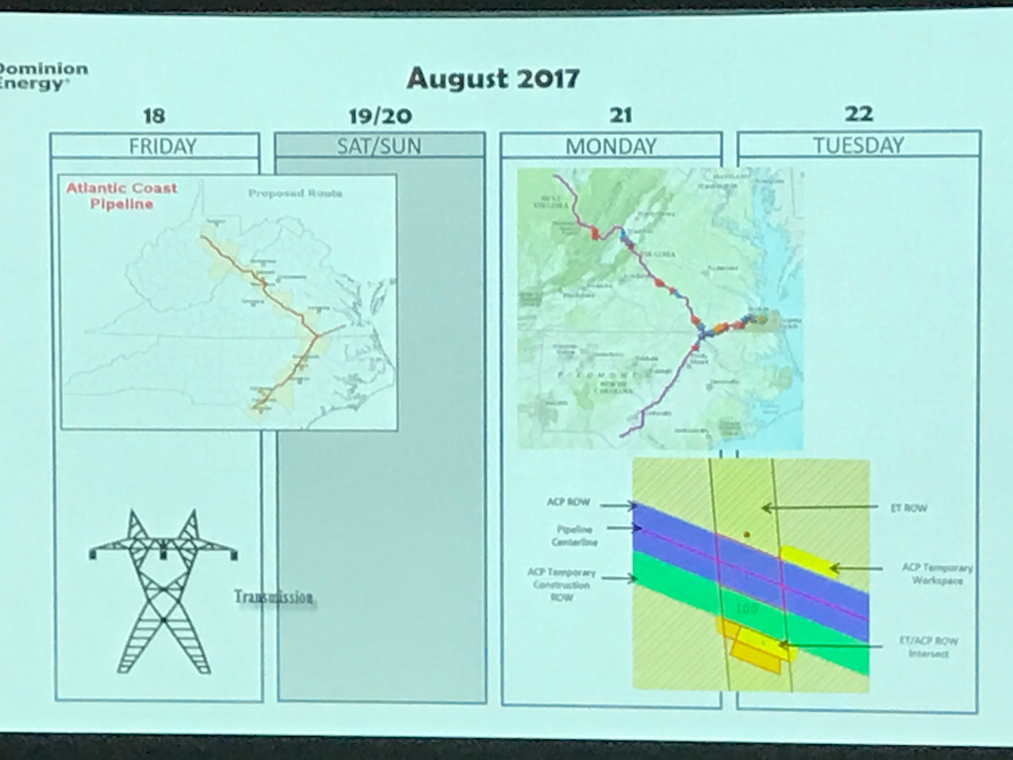
The company’s transformation became apparent on a project to construct a new 450-mile gas transmission pipeline from West Virginia across Virginia and into North Carolina. Prior to the first meeting with leadership, the GIS team created the Atlantic Coast Pipeline (ACP) Viewer to visualize the pipeline route, including parcel data. The ACP Viewer was expanded to visualize the full pipeline route.
The combination of Portal and Collector allowed for the quick development of user-friendly and dynamic applications. Several basic asset viewers have been created to allow the leadership team to evaluate incoming data and ask deeper question about the organization’s infrastructure.
The greater visibility of GIS data has improved Dominion Energy’s ability to make data data-driven decisions.
10:30am - Break time! We'll be back in 15 minutes.
10:45 am - What is Digital Transformation
After a short break we are back with bmeehan-esristaff Director, Infrastructure Marketing at Esri. Bill talks about the Digital Transformation. With digital transformation we need to talk and think about it in a different way, not just about technology, but rethinking how we work and play. Digital transformation is about being connected.
Bill took us through a couple of examples of digital transformations we have seen. The AAA Trip Tics to Waze, Waze uses not only navigation but also crowd sourcing and business analysis. "Then think about Uber, this is a great example of digital transformation, taking the way we use to behave and turn it upside down. Uber knows who I am, where I am and my payment information."
Digital transformation is about where things are happening and balancing the needs of your stakeholders- owners, customers, employees and communities.
The good news- the world is going through a transformation, the energy business in particular is being upended with micro grids and decentralization. We are here to help you empower your GIS to transform your world.
11 am - Tools to help you transform
Hunter West takes us through tools and enhancements to help transform your GIS, like World Imagery, Vector Tiles, and Smart Mapping.
11:15 -11:30 am
Esri Staff continued taking us through how to use different features of the ArcGIS platform.
11:41 am - ArcGIS App for the fields
Brian Baldwin, Drone2Map for ArcGIS
There is an area in southern California called the Cajon Pass. It lies between LA and Las Vegas, where travelers pass through. This area includes major transmission, highway corridor and rail lines, and last year a major fire shut down this region. "With a partner and licensed drone I was able to do an inspection of the towers, build out 2D image products, use 3D features form Drone2Map to build out point cloud."
This is an example of how Drone2Map can be used as a field application. It provided building out imagery with incredible resolution.
11:50 am
Joe Marsh took us through the Business Analyst App
11:52 am - Real-Time GIS
Brian Baldwin showed us how to use Real Time GIS. This is very helpful in disasters responses, like Harvey. Brian showed us how to add data layers using the Living Atlas.
Be sure to check out the https://community.esri.com/groups/disaster-response-program?sr=search&searchId=0474cf7b-17dd-43a3-aa... group on GeoNet.
11:55am - Utility Network
Larry Young takes us through the news about the ArcGIS Utility Network Management Extension.
Network management tools for the next 15+ years.
- Electric, gas, water, storm water, sewer, telecom, etc.
Vision Statement
- Provide utility customers the ability to model, edit, and analyze complex networks leveraging the entire ArcGIS platform
- Enable modeling concepts to better support true representations of what is on the ground, while fostering an easy exchange of network information with other mission critical systems
- Provide a highly responsive editing and analysis environment
Increasing your ROI
- Services based architecture for enabling the platform
- Real world representation of what is on the ground
- Multi-domain networks (e.g., combined fiber, electric, gas, and water)
- Scale to continent-wide datasets
- Sophisticated analysis
- Ensuring data quality and correctness
- Subnetwork management
- Improved mapping and visualization techniques
- Expanded data exchange capabilities
- Increased performance
- A strong foundation for our customers and partners

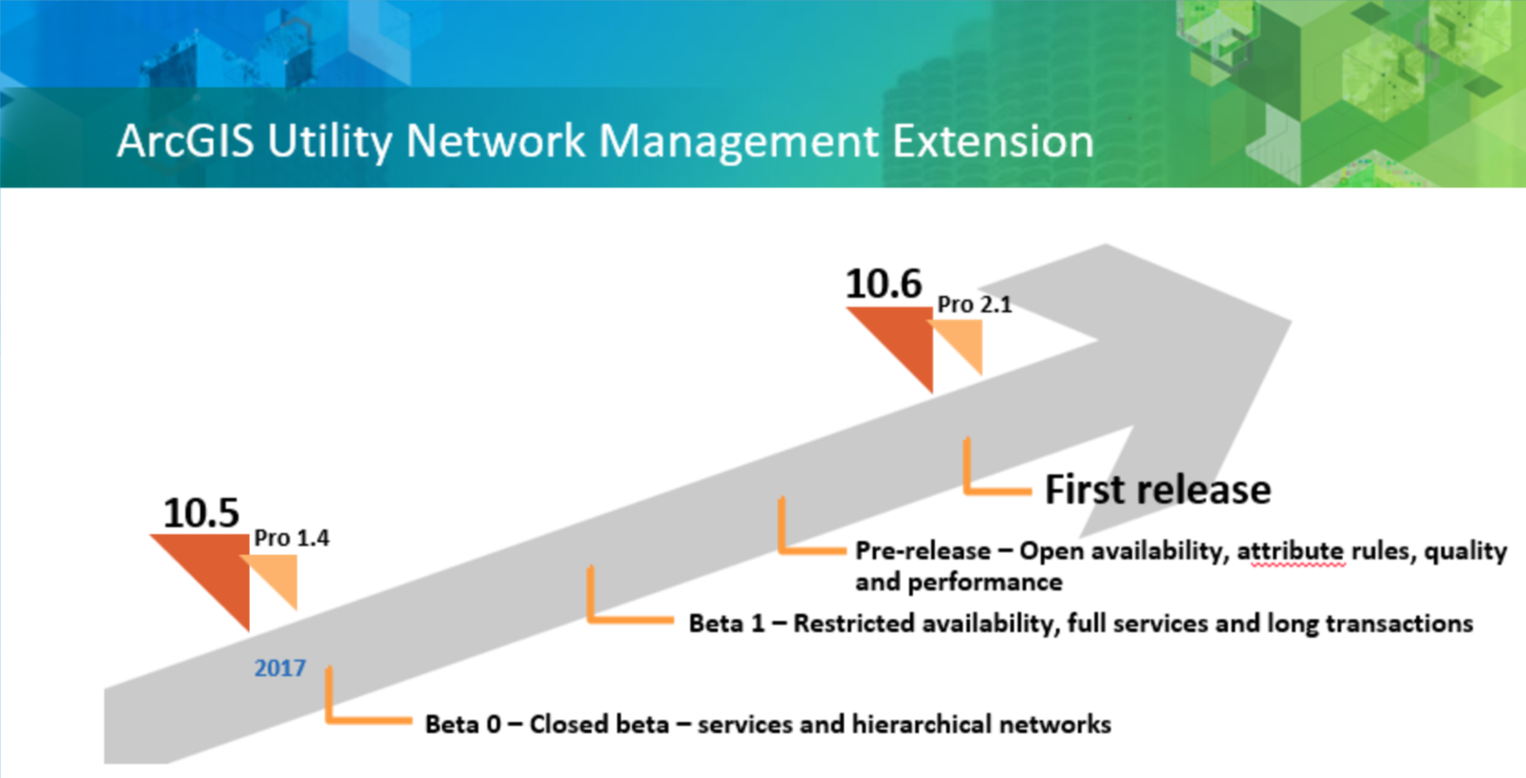
12:15pm - That's a wrap for the GeoConX Plenary! Thanks for joining us and be sure to follow along the rest of the day and week in the https://community.esri.com/community/utilities-and-communications?sr=search&searchId=f73d7e0d-5ae6-4... group on GeoNet.
You must be a registered user to add a comment. If you've already registered, sign in. Otherwise, register and sign in.